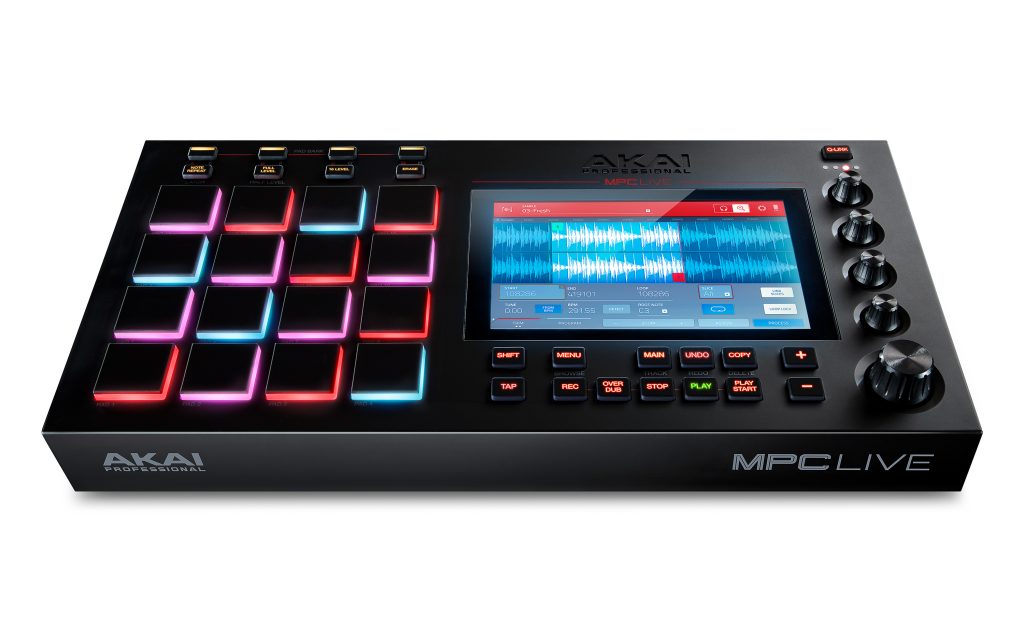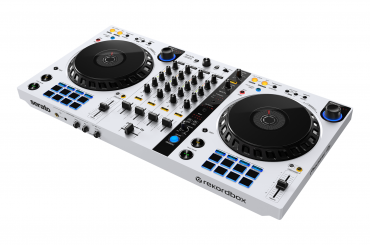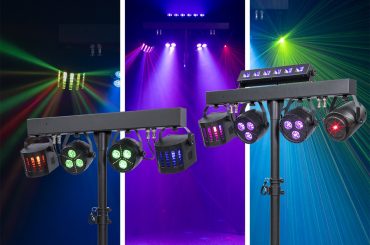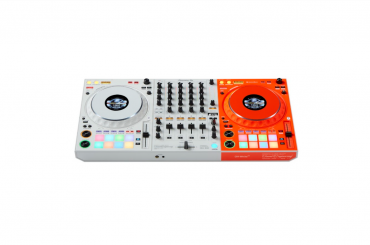At the beginning of the year when I first saw the promotional videos for the MPC X and MPC Live, both of which Akai Professional debuted at the Winter NAMM show this past January, I knew that I had to review one of them.
It certainly seemed like Akai Pro’s parent company, the Cumberland, R.I.-based inMusic, had a couple of hot new products that updated the legendary MPC line of production tools. So, after some consideration, I opted for the MPC Live because of its smaller size and portability.
We all know the MPC’s huge influence in pop, urban and electronic music over the last generation, and the legacy will most certainly continue with these two new offerings. Weighing in at 5.9 pounds, the MPC Live is a powerhouse. Don’t let its small stature fool you at all. Akai has done a fantastic job packing this little guy with all sorts of features that enhance workflow and open up a nice array of options for live performance – hence the name, MPC Live.
First, let me mention some of the specs: 16 velocity and pressure sensitive pads; eight different pad banks; four Q-Link knobs and columns; 2 GB of RAM; and a 16 GB internal drive. The unit ships with 16 GB of onboard storage – 10 GB of pre-installed content, 6 GB remaining for additional storage. So, it’s a good thing that space was left for the installation of a 2.5-inch SATA drive (HDD or SSD), for extra storage space.
I’m considering putting a 1TB SSD in my unit, but for the moment, I am using a 64 GB USB 3.0 stick with one of the two USB 3.0 ports on the back of the unit. And, so far so good!
There is also an SD card slot, along with two sets of MIDI I/O, RCA inputs (and a ground peg) for a turntable, 1/8-inch headphone out, 6-¼-inch TRS outputs and 2-¼-inch TRS inputs. The display is 6.9-inch and is full-color LED-backlit, as well as touch screen. Oh, and I almost forgot mention the lithium ion battery that offers around five hours of use without AC power. Class-compliant MIDI controllers and ASCI keyboards can connect to the USB 3.0 ports, in the event you want to add those types of peripherals.
The MPC is designed to be a stand-alone music production center, and Akai has really taken some big steps forward by integrating audio. That’s correct, you can now import and/or record up to eight tracks of audio in a sequence. Users have the ability to warp their audio, so your loop will lock to the BPM of your sequence. If you are running the 2.0 desktop software, and your computer is fast enough, you can have up to 128 tracks of audio.
When you register your MPC on the Akai website, you will be given a serial number to download the 2.0 desktop software. Since this is a review of the MPC Live and not the desktop software, I’m only going to mention a couple of important points about the software.
The newly designed 2.0 software is a huge improvement over the Version 1 software. Most importantly, support for VSTs is now available, and when you add the integration of audio, these are game-changers, in my opinion. Also, the MPC Live can be used as a control surface with the 2.0 software, much like the MPC Touch.
If you’ve ever worked on an MPC, then you understand that there is a special “feel” to building tracks on it. From the quantization to the expressiveness of the pads, for me, there isn’t anything else like it. I have to say that the included content is fantastic. The Vault 2.0 includes top-notch content from companies like CAPSUN ProAudio, MVP Loops and CR2 Records.
It did take me a couple of days to get comfortable navigating the unit. Coming over from an MPC 1000, I wasn’t accustomed to all of the new menus, subfolders, and touch-screen capabilities, but once I got the lay of the land, I was off and running. And, my old MPC 1000 program files and samples loaded up just fine.
For those of you who may be new to the MPC ecosystem and terminology, a program is made up of a collection of samples, and a sequence is the recorded performance of those samples on different tracks. A song is made up of one or more sequences, and a project contains the song, sequences, programs and samples.
I would be remiss if I didn’t mention the use of the MPC Live for live performing. Users have the ability to launch clips directly from the pads, and the pads themselves are color-assignable. Pads can also be used to trigger different sequences, opening up all sorts of possibilities with live arranging, and extending sections songs. Future features include WiFi, which will be mainly for an Ableton Live link, and Bluetooth, which will support Bluetooth MIDI control (no outgoing MIDI).
In case you can’t tell, I love the MPC Live. I think the workflow is fantastic and, as you have ability to “Explode” (or stem out) your tracks, it is seamless to move files out of the unit and into other DAWs, if that’s how you prefer to work. Keep in mind that when you connect the unit to the computer, the internal drive will not mount on the desktop. If you do install an additional drive, that drive will mount. But, you can get quite a bit of mileage out of USB 3.0 and SD cards, and you may find them to be sufficient for your needs.
Also, projects that were created on the unit will open up in the 2.0 software and vice-versa. The only caveat is that if you are using VSTs in your 2.0 session, they will not open up in the unit. Don’t shy away from taking your production all the way to mixdown from within the unit itself. There is a nice selection of onboard effects that shouldn’t be overlooked.
Producers, performers and DJs should definitely take one for a test drive at your local pro audio dealer. With a street price of $1,199, the MPC Live is a great buy. You are getting a control surface, along with a feature-rich, stand-alone music production center, all of the connectivity for peripherals, and the ability to work without AC power. Well-done, Team Akai, well-done!









